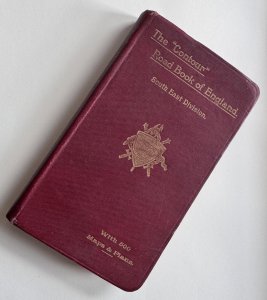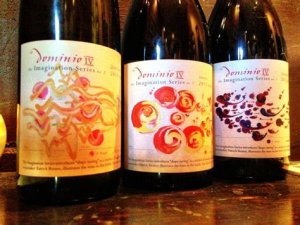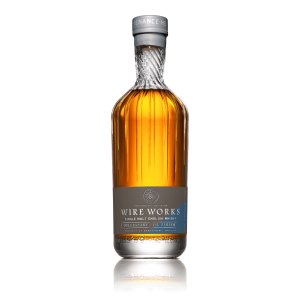The Weekly Mash, Friday 1st August
After last week’s diversion into the world of rum, we return to whisky… and roads, and shapes, newies from Fielden and White Peak, plus Townes van Zandt. Value for money (well, value for no money)

Shaping Up
I was browsing in my local Oxfam bookstore, seeing which volumes Nick Cave had donated and, after grabbing a clutch, wandered around to the ‘Collectable’ section which is mostly old orange Penguins and the odd faux leather-bound volume. One of the latter caught my eye, ‘The “Contour” Road Book of England (South East Division) printed in 1908, the early days of motoring.
In 500 maps, it details all the main roads between cities and towns, their length, road surface and, most importantly in those days of over-heating radiators, gradients. Each route comes with a cross section showing its dips and falls.
I find them captivating. They show the need to have something like this to hand when embarking on a trip. The gradient maps give you prior warning of what to expect and how to prepare, allowing you to work out if your vehicle could cope. The inclusion of hotels and inns in each entry would be a great help.
GPS has created a flat earth whose function is to plot the quickest way from A to B. The road book’s cross-sections show the ups and downs of a journey. They describe the road itself, the journey, place you in the landscape. The shape of the road makes more sense. It offers a different way of mapping.

Tasting notes are like GPS systems. I’ve been pushing against the tyranny of the tasting note for years. Of course I understand their usefulness – giving a rough idea of what flavours to expect, but by nature they are formulaic. Here’s the colour, nose, now the palate, then the finish.
The experience of tasting (itself an engaged experience) is reduced to a list of descriptors. Can you ever use language to express fully a sensory phenomenon? It Can reading a transcription of Coltrane’s ‘A Love Supreme’ ever be the same as hearing the music? Can you write sound? Can you write taste? Maybe it’s impossible to do fully, but are there ways to give a fuller idea of the phenomenon?
I love exploring the concept of cross-modality, of how all of our senses are interlinked. Mostly it’s been in classes showing how different tempos and pitches of music can accentuate different elements in a whisky. Mood music is indeed moody. In other words, to some degree we’re all synaesthesic.
It’s shown in the words we use in our tasting notes: fruits are green, red, or black. There’s lemon, orange, grass, tar, smoke. Colour is built into our understanding of a whisky.
I think about colour when tasting, but I think more about shape the whisky makes in the mouth. Some are straight down the middle of the tongue, some spread out and across it. Others will fill the mouth, coating the tongue and the top palate. There are whiskies which are diamond shaped, or rise like a hill with flatlands on either side. Some behave like ski jumps, starting with a peak and then diminishing – others do the reverse. You’ll find linear whiskies where the flavours follow ach other is a clear progression while there are some which layer flavours and textures on top of each other. Tasting is about a transference of energy. Not just shape but speed. Why do we rarely talk about that?

I’ve been wrestling with this conundrum for a number of years which is how I came across the work of winemaker Patrick Reuter who owns Dominio IV in Oregon. He’d also been chafing against the tasting note’s rigidity and failure to truly describe what was going on. Returning to his own notes he found he couldn’t imagine the wine he’d written about from the words on the page.
So he began to draw what he was tasting. Sketching the sensations rather than just listing flavours, acidity and tanning. They showed breadth, length, direction and pace, the points where flavours emerged, melded and faded. Functional art that helped him with blending, deepening his understanding of what he was making. They’re in the same world as those 1908 contour maps – the journey and progression, the ups and downs and pauses, even the speed.

That was a good few years ago and though I’m no artist, it helped to change the way I which I tasted and tried to interpret what was going on. I have a vague memory that over one of our annual Long Lunches, John Glaser and I had an idea of doing a shape tasting artwork for Compass Box but it never happened. One of the (few) downsides of Lunching is that so many great ideas are forgotten.
I pitched a piece a few times, but there was no interest. So here it is … I did a quick search to see if Patrick was still doing his shape tasting pieces. A video popped up of him with Miles Munroe of Portland’s Westward Whiskey. Of course these two Oregonians would get together!
Miles had finished two of his single malts in a pair of casks from Dominio IV (a Tempranillo and a Pinot) and Patrick did a taste shape artwork as he was tasting. They’re on the labels. Maybe I’m not alone.
————————————
In The Cupboard (but not for long)
Fielden Hazybower (46.3%/£102.50)
Summer is apparently here and with it comes a change in seasonal flavours. If spring whiskies are all about blossom, sharp fruits and cut grass, then summer is softer and sweeter. Its whiskies are gentle and languorous. American oak’s creaminess increases, the mid is filled with pictures suggestive of beaches and juicy fruits.
This new Fielden LINK is redolent of a cool summer evening, the heat just dying, a cooling breeze tickling your limbs. It’s a 1,000 bottle release and is the second member of the Fieldnotes series, each of which features one aspect of the distillery’s approach to English rye.
It is made from a diverse field mix of heritage rye, wheat and barley, the spirit then aged primarily in re-used American oak casks with a portion fully matured in an old Hungarian oak Tokaji cask.
It occupies rye’s fragrant side with a floral note balanced by dry earth before there’s peppermint, green herbs and a cooling lemon hit. In time there’s the sensation of peeling an orange – the smell of the white pith, followed by the spray of oils. Water brings out almond milk and osmanthus.
It starts with tingling, tight, bright citrus before it softens, slows and relaxes into creaminess, some hot cross bun dough, and blood orange. The spices then pick up and the velocity increases as baking spices, ginger and pepper fizz and pop There’s a twist of grapefruit as it starts to dry. A beauty.
On the shelf
 Wire Works Necessary Evil Finish (51.3%/£69) Derbyshire’s White Peak distillery and the nearby Thornbridge brewery have been working together from the get-go, with the brewery supplying the distillery’s yeast. The pair have also collaborated with ageing the whisky in casks that have been used for Thornbridge’s ‘Necessary Evil’ Imperial stout.
Wire Works Necessary Evil Finish (51.3%/£69) Derbyshire’s White Peak distillery and the nearby Thornbridge brewery have been working together from the get-go, with the brewery supplying the distillery’s yeast. The pair have also collaborated with ageing the whisky in casks that have been used for Thornbridge’s ‘Necessary Evil’ Imperial stout.
This, the third in the series, is a lightly peated whisky which started off in ex-Bourbon barrels before being finished for eight months in STR casks which had first been used for the whisky and then for the stout. (Still with me?)
The aroma is thick with deep dark fruits, some heavily roasted coffee beans (aromatically linking peat and malt), wholemeal bread, toasted hazelnut, malt extract and an underpinning of tablet.
It’s slower and broader than the Fielden, chewier in texture with a minty element along with the nuts. It expands and deepens in the centre adding in milk chocolate, cinder toffee, chewy tannins, plum, and hedgerow fruits. Underneath this is the spine of acidity which defines White Peaks style.
It narrows a little towards the back adding in liquorice, black cherry, dried red fruits and a little smoke before, with an uptick, the acids break free. Great dram, great value.
————————————

In my ears
This week has been a return to and immersion in the collected works of the troubled Texan troubadour, the late great Townes van Zandt. So much to choose from so here’s a clutch as a reminder or an introduction.
To Live Is To Fly, Waiting Around To Die, No Place to Fall and of course his only hit Pancho and Lefty